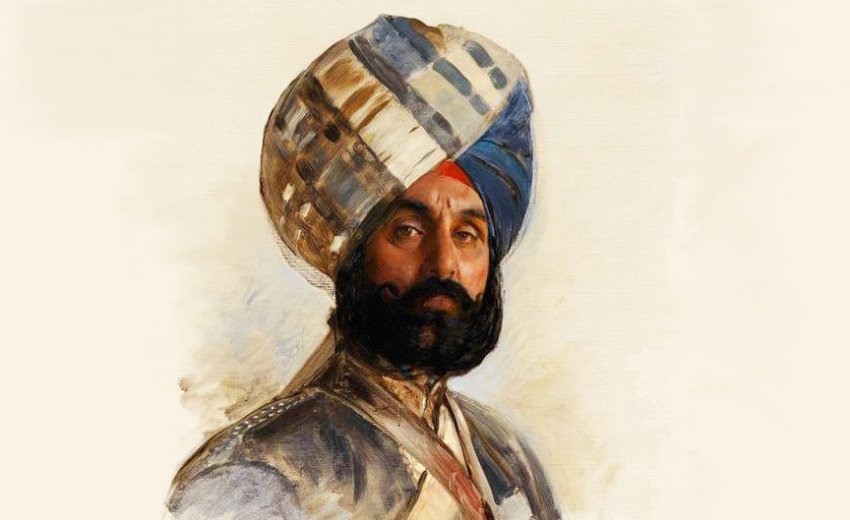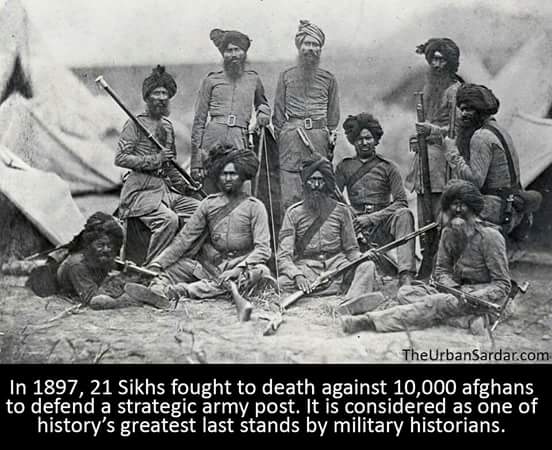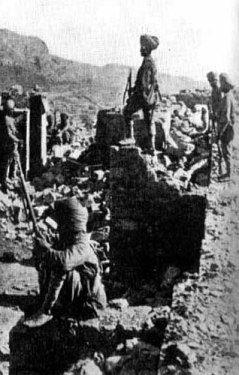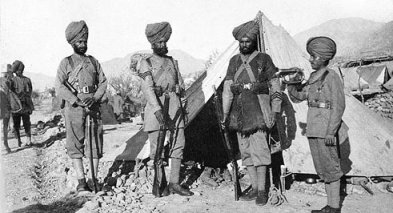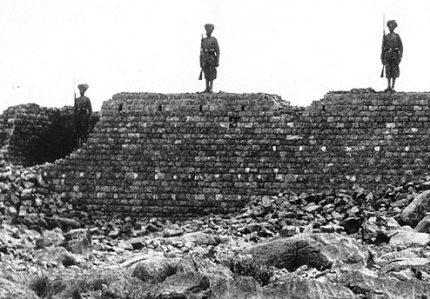September 12, 1897
Outnumbered and surrounded, still the men fought on with a
stubbornness and pride for which the Sikhs have long been known.
The Battle of Saragarhi was fought before the Tirah Campaign on September 12, 1897 between twenty-one Sikhs of the 36th Sikhs of British India, defending an army post, and 10,000 Afghan and Orakzai tribesmen.
The defense of the tiny-yet-critical British fortress at Saragarhi is one of the most storied and famous tales of skull-crushing bravery in the military history of the Sikh people. The middle-finger-u-death response of the ferocious 21 men who bravely held their ground against impossible odds is often held up as the ultimate example of Sikh attitude, which is really saying something considering that these Indians have stories like the dude who ran around pureeing enemy soldiers apart even after being mostly decapitated by a broadsword to the throat. Yet despite this epic showdown being the basis for a national holiday among Sikhs and a valiant, head-cleaving last stand worthy of the Spartans at Thermopylae, this insane tale of 21 warriors going Horde Mode against roughly the entire male population of Central Asia in a single battle remains largely undocumented in Western military histories. This is their tale.
The story starts near the end of the 19th century (or, as the British like to call it, "The Good Old Days"), when the British Empire stretched from sea to shining sea and the Queen convinced one-quarter of the world's population that drinking tea at 4pm was "totally bodacious" and/or "off the chain" (they used lots of outdated terminology back then). The British Raj was ruling over India, providing enlightened governance and guidance in exchange for shiploads and shiploads of valuable natural resources, and the Empire oversaw the defense of the subcontinent thanks to a series of awesome mountain fortresses positioned along the border between present-day Pakistan and Afghanistan.
While it wasn't particularly well-fortified or heavily-garrisoned, the outpost at Saragarhi was a seriously critical communications relay position between two major British forts. It played a crucial role in the first line of defense of British India against the tribal warriors of Central Asia – the Orakazai and the Afridi – and these guys knew that if they ever wanted to wreak havoc on the subcontinent and punch the Rajah in the Crown Jewels they were going to need to get past this defensive outpost first.
On the morning of September 12, 1897, signalman Gurmukh Singh of the 36th Sikh Regiment looked out into the horizon and, to his surprise, he saw regimental battle flags. A massive sea of colors, swirling dust, and more enemy soldiers than you could shake a Kirpan at, even if you'd built some kind of mechanical rig designed for the sole purpose of shaking Kirpans at things. Unable get his Rain Man on and count how many troops were in the sheer horde of rampaging warriors marching his way, Singh just quickly tallied up the regimental flags and signaled the alarm. When he rushed down from his tower and found his commanding officer – a lowly Havildar (Sergeant) named Ishar Singh – he put the estimate on the number of assailants at somewhere between 10,000 and 20,000 riflemen. Oh, plus an unknown amount of heavy artillery. And probably some other shit too.
Havildar Singh called his garrison together for an emergency meeting. Standing before him in the tiny courtyard of this small, mud-and-stone garrison was the entire detachment of the 36th Sikhs assigned to the defense of this critical strategic outpost – all 20 men of it. Calmly, honestly, with no fear in his voice, the non-commissioned officer told his troops that they were most likely the last and only bastion of defense between that teeming throng of blood-thirsty warriors and the heart of India herself – these 21 soldiers were the only thing even remotely in a position to slowing down a coordinated tactical strike that was guaranteed to take the British and Indian defenders by surprise and wreak havoc across the land. He also told them that even though he knew how much lay at stake here, he wasn't about to order his men to their deaths in a hopeless battle they had no chance of surviving.
The men had a choice to make – stand here and defend India against this invasion, hold back the assault as long as possible, and die valiantly in battle, or abandon their position and retreat to the nearby Fort Lockhart where a more sizeable British force was stationed. He put it to a vote among the men. Since they were all going to fight, serve, die, or flee together, they needed to stand as one.
All twenty men voted to stay.
Gurmukh Singh relayed word of this ungodly massive sneak-attack to a nearby British fort as the doomed Sikhs fortified their mud-walled fort as best they could and braced themselves for the onslaught. At 9am, the first of the enemy came into range of their weapons. Havildar Singh issued the order to fire at will, and the 21 men of the 36th Sikhs began to bust out one of the most epic last stands in history.
The Orakazai and Afridi did the sort of thing you'd expect from an overwhelmingly-powerful force assaulting a tiny podunk outpost garrisoned by a force they outnumber roughly 500:1 – they charged out, Emperor Xerxes-style, looking to overrun the defenders by hurling wave after wave of their own men at the walls. It didn't work out so hot for them. This giganticly ridiculous horde of maniacs thought they were going to completely bulldoze the Saragarhi Sikhs, but the admittedly-hardcore Orakazai quickly realized that these weren't any chumps manning the defenses here – these were gnarly gnarlington high priest Vatican assassin warlocks ready to deploy their ordinance to the ground, and all these Sikhs came here to do was WIN.
On two separate attacks the Orakazai hurled themselves at the walls of Saragarhi, climbing the walls on ladders, laying heavy rifle and cannon fire into the fortress, and on both occasions the 21 defenders shielded themselves, kicked down the ladders, and barfed out enough rifle fire to drive the attackers back. This is completely insane, especially considering that the Sikhs didn't exactly have access to heavy machine guns or assault rifles back in 1897 – these out-of-their-mind warriors were basically using damned bolt-action rifles, and were somehow firing them so retardedly fast that 10,000 trained warriors with guns somehow found themselves unable to push their way through this ridiculous curtain of leaden deathy evilness.
Meanwhile, when he wasn't taking potshots from the signal tower with his scoped rifle, the garrison's signalman, Gurmukh Singh, was operating his signaling equipment and informing the nearest British outpost (just barely visible in the distance beyond the ridge) exactly what was going on, how many men the enemy had, and what sort of equipment they were carrying. No sweat, right?
While wagerers probably would have set the over/under for the duration of this fight at about fifteen minutes, five hours into the combat the Sikhs were still managing to hold out against all odds. Sure, they'd taken a few hits here and there, but even the wounded men were propped up on the battlements laying down fire on the attackers as best they could. Completely surrounded by a massive mob of troops, these guys continued to dish out withering gunfire with accuracy.
Eventually, while the Sikhs were completely overwhelmed by attacks on all sides, a team of Orakazai sappers breached through a particularly lightly-defended section of the outer defenses, snuck in, and set fire to the fort. Their positions concealed by the smoke and flames, and the Sikhs concerned with extinguishing their burning fortress, the rest of the enemy troops managed to charge in and break through the outer walls of the fort, rushing into the courtyard.
With their own fortress walls crumbling and smoldering around them in an inferno of shittiness, the Sikhs continued to stand by their initial assessment of, "You Are Only Getting Through Here Over Our Dead Bodies". Havildar Singh ordered his men to fall back to the inner section of the fort, barricade the walls, and continue laying down fire on the attackers who were now swarming over the walls. Singh himself didn't make it back – in an effort to buy his men time to fall back he drew his Kirpan dagger, charged into the horde, and died valiantly in hand-to-hand combat against an impossible swarm of rifle-swinging tribesmen.
So even now, seven hours into the battle, with their commander dead, their ammunition dwindling, and their fort burning down around them, the Sikhs continued to stick it to the Orakazai with everything they could muster. It didn't take long for the enemy to find the weak point in the inner defenses – a rickety wooden gate that was already on fire – yet still, even when the tribesmen shot up the gate, stormed the wall, and breached through to the main building of Saragarhi, they blitzed through only to find a determined handful of pissed-off Sikhs standing there with fixed bayonets and vicious scowls. There wasn't going to be any Gandalf the White riding in on a hurricane of fireballs this time... these were going to have to take matters up into the points of their blades and finish this like men.
Seeing enemies inside the tower, signalman Gurmukh Singh issued his last communications to the British, dropped his signal gear, and took up his rifle, laying down sniper fire on the enemy troops swarming over his friends below. He is credited with killing twenty men by himself, and it is believed that when he ran out of bullets he fixed his bayonet and charged down into the frayshouting the battle cry of the Sikhs – "He who cries 'God is Truth' is ever victorious." When British troops reached the position later, they found 21 dead Sikhs and somewhere between 180 and 800 dead tribesmen. The number is debated because when the British showed up there was a second round of fighting over the fort, and it was difficult to say how many enemies were killed between the two fights, but we do know that nearly every single Sikh rifleman was completely out of ammunition. They had started with 400 rounds each.
The defenders of Saragarhi were slain to the man, but they had held their position all day and well into the evening, delaying the massive onslaught just long enough for the British to get their shit together and reinforce the position. After Saragarhi, the Orakazai moved on to the nearby Fort Gulistan, but the delay at Saragarhi had cost them the element of surprise – the men at Fort Gulistan were ready for them, and they held the attack back while freshly-arrived British heavy artillery dropped a few hundred high explosive shells right into the middle of the enemy horde.
When the story of the Sikhs at Sargahiri was recounted to Parliament, it received a standing ovation from every member of the British government. All 21 Sikhs received the Indian Order of Merit, the highest military award available to them at the time, and their families each received a plot of land and 500 Rupees in cash (the current exchange rate lists 500 Rupees amounts as being equal to about $10.85 USD, but it was probably worth a lot more back in 1897... though I'm only basing this on the fact that in 1987 500 Rupees is nearly enough to buy two Blue Rings, and those were by far the most expensive items in The Legend of Zelda.) The tale was mentioned by UNESCO as being as one of eight great stories of collective bravery in human history, and to this day, every September 12th the people of India celebrate Saragarhi Day. -- Source.

